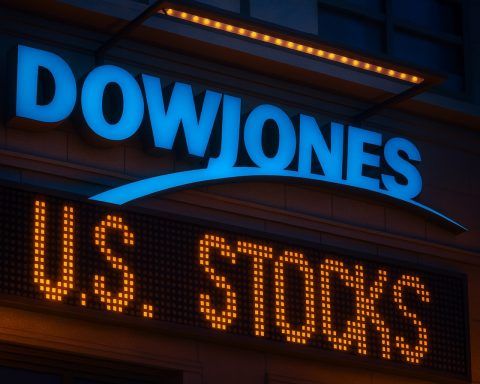Micron Technology’s stock is back under pressure on Friday as Wall Street continues to digest a brutal two‑day slide triggered by management’s warning that capital spending will likely run even higher to keep up with surging AI memory demand.
By late morning U.S. trading on November 21, Micron (NASDAQ: MU) was changing hands around $193, down roughly 4% on the day after opening above $204 and trading between an intraday high of $205.94 and a low near $193.07.
That follows Thursday’s 10.9% plunge to a close of $201.37, Micron’s fourth straight daily decline and part of a roughly 15% pullback over the past 10 sessions, according to technical service StockInvest. [1]
Yet even after this week’s sell‑off, Micron is still one of 2025’s standout winners: Simply Wall St estimates the shares are up about 130.6% year‑to‑date and almost 97% over the last year, even after a 15% drop in the past week. [2]
Micron (MU) stock snapshot – November 21, 2025
As of late morning U.S. trading (approximate):
- Last price: ~$193.08, down about 4.1% from Thursday’s close of $201.37. [3]
- Intraday range: $193.07 – $205.94.
- Recent volatility: Thursday’s session saw a 15.5% intraday swing and a 10.87% drop on the day. [4]
- 52‑week range: roughly $61.54 (April 7, 2025) to $260.58 (November 17, 2025). [5]
- Market capitalization: around $225–227 billion, based on recent price and MarketBeat/Yahoo Finance figures. [6]
- Next earnings report:
- Fiscal Q1 2026 results due December 17, 2025.
- Zacks/European coverage point to a consensus EPS forecast around $3.57, more than double the $1.62 earned a year earlier. [7]
- TradingView and Seeking Alpha data suggest Wall Street is looking for ~$3.7–$3.8 EPS and about $12.6 billion in revenue next quarter. [8]
The trigger: RBC Global Technology Conference and a capex shock
This week’s downdraft really traces back to Micron’s appearance at RBC Capital Markets’ 2025 Global Technology, Internet, Media & Telecom Conference.
At that event, Micron executives delivered two messages that the market is now trying to reconcile:
- AI memory demand is off the charts
- Micron told investors that all of its High‑Bandwidth Memory (HBM) capacity through calendar 2026 is already spoken for. Both current HBM3E chips and next‑gen HBM4 are effectively sold out. [9]
- Management said the company recently posted a 51.5% gross margin in its first fiscal quarter and expects margins to improve further as AI data‑center demand accelerates. [10]
- The roadmap calls for HBM4 shipments to begin in Q2 2026, using TSMC base dies, and Micron now claims an HBM market share similar to its DRAM share despite being a late entrant. [11]
- But capital spending will likely have to go even higher
- CFO Mark Murphy and CEO Sanjay Mehrotra indicated that Micron’s current ~$18 billion annual CapEx run‑rate is likely to come under pressure as multi‑year AI supply agreements and tight memory markets extend beyond 2026. [12]
- European coverage of the conference notes that Murphy described significantly higher capex for AI chips as “unavoidable,” stoking fears about a squeeze on free cash flow even as demand booms. [13]
- At the same time, Micron continues to pay down debt to below $12 billion, aims to move into a net‑cash position, and has already executed about $300 million in share repurchases. [14]
The result is a classic growth‑vs‑cash‑flow trade‑off: investors love the idea of sold‑out AI memory capacity at fat margins, but they are suddenly being asked to accept even larger upfront investment to get there.
Why Micron is still sliding today
1. Two‑day “hangover” from Thursday’s crash
On Thursday, November 20, Micron shares dropped 10.87% to $201.37, their worst single‑day percentage decline since April, on very heavy volume of roughly 47 million shares, according to StockInvest. [15]
A 24/7 Wall St. piece on Friday notes that MU sank as much as 11% during Thursday’s sell‑off and briefly broke below the psychologically important $200 level before closing just above it. [16]
Today’s move looks like follow‑through selling and profit‑taking rather than a fresh negative headline:
- The 24/7 Wall St. article points out that MU is down another ~3.6% today, with investors “spooked” by Micron’s aggressive AI capex plans and the admission that its $18 billion spending plan faces headwinds. [17]
- The same piece reminds readers that the stock is up more than 100% year‑to‑date, making it a natural target for profit‑taking once sentiment turns. [18]
European coverage from Börse Express goes even further, describing a “roller coaster” in Micron’s share price and estimating that the stock is down around 19% over the week as investors weigh long‑term AI potential against exploding near‑term costs. [19]
2. AI memory boom is real – and tightening the screws
The irony is that almost every data point around Micron’s end‑markets is bullish:
- The RBC/Boerse‑Global write‑ups stress that Micron expects memory tightness to last beyond 2026, with DRAM inventories below target levels and limited cleanroom capacity across the industry. That backdrop has allowed Micron to implement what management calls “robust pricing trends” across business lines. [20]
- A separate Network World report warns that server memory prices could double by the end of 2026 as vendors pivot capacity toward AI workloads. DRAM prices are estimated to be up roughly 50% year‑to‑date, with forecasts for another 30% increase in Q4 2025 and 20% more in early 2026. [21]
- That same report notes that Samsung and SK Hynix have already sold out HBM, DRAM and NAND capacity through 2026, and that Micron has raised some memory prices by 20–30% and even stopped quoting certain products amid tight supply. [22]
So the fundamental narrative is powerful: AI has turned high‑performance memory into a scarcity asset, and Micron is one of only a few companies that can manufacture leading‑edge DRAM and HBM at scale. The market’s worry is not demand, but how much capital Micron must spend – and how quickly – to monetize that demand without crushing free cash flow.
What Wall Street is saying about MU on November 21
Zacks: Micron as both a growth and value play
Zacks Investment Research doubled down on Micron on Friday with two separate pieces:
- In “Best Growth Stocks to Buy for Nov. 21st,” Zacks includes Micron (MU) as one of three highlighted names, citing its Zacks Rank #1 (Strong Buy) and favorable growth profile. [23]
- A separate Zacks article, “Why Micron (MU) is a Top Value Stock for the Long‑Term,” notes that:
- Micron carries a VGM Score of A (combining value, growth and momentum) and a Value Style Score of B.
- The stock trades at a forward P/E of about 12, which Zacks sees as attractive relative to its growth outlook.
- Nine analysts have raised their EPS estimates for fiscal 2026 in the last 60 days, lifting the consensus to roughly $16.79 per share, and Micron has delivered an average earnings surprise of about 9.4%. [24]
That combination – Strong Buy rating, upward estimate revisions and discounted forward P/E – is why Zacks argues Micron should be on investors’ short list despite near‑term volatility.
StockStory and Trefis: high growth vs peers
A Finviz/StockStory piece titled “1 S&P 500 Stock with Promising Prospects and 2 We Avoid” singles out Micron as the one S&P 500 name to watch, highlighting that:
- Micron’s revenue has grown 55.1% annually over the past two years.
- Analysts expect ~49% revenue growth over the next year, implying further market share gains.
- EPS has compounded at about 24% annually over the last five years.
- Even after the rally, Micron trades around 12x forward earnings, according to the article’s estimates. [25]
Meanwhile, Trefis argues in “Why MU Could Outperform Texas Instruments Stock” that Micron offers stronger growth at a comparable or lower valuation than Texas Instruments (TXN):
- Micron’s latest‑twelve‑month revenue growth is cited around 49%, versus under 10% for TXN.
- Operating income growth has been dramatically higher at Micron (over 600% LTM in the Trefis table), compared with single‑digit growth at TXN.
- Micron’s price‑to‑operating‑income multiple is slightly below that of TXN, and its price‑to‑sales ratio (~6x) is lower than TXN’s (~8x). [26]
The takeaway: relative to some blue‑chip analog peers, Micron still screens as the higher‑growth name without an obviously richer valuation.
Simply Wall St: valuation signals are mixed
Not everyone thinks Micron is cheap here. A fresh Simply Wall St note titled “Is Micron Technology Still a Smart Bet After a 130% Surge in 2025?” takes a more cautious view:
- It estimates Micron is up 130.6% year‑to‑date but down 15% over the last week, underscoring the stock’s violent swings. [27]
- A discounted cash flow (DCF) model in the article pegs Micron’s intrinsic value at about $102.30 per share, which the authors say is roughly 97% below the current share price, implying substantial overvaluation on that metric. [28]
- However, they also note that Micron’s current P/E of ~26.5x is below a semiconductor industry average of ~32.8x, and their proprietary “Fair Ratio” would justify a much higher P/E of around 43x, which makes the stock look undervalued on an earnings‑multiple basis. [29]
Simply Wall St ultimately gives Micron a 3/6 score on its valuation checks, framing the stock as neither clearly cheap nor obviously doomed at these levels – instead, investors are encouraged to build their own narrative about AI growth, margins and risk. [30]
Street targets: still very bullish, even after the drop
Despite the recent shake‑out, the sell‑side consensus remains firmly positive:
- TD Cowen recently raised its Micron price target to $275 and reiterated a bullish view, pointing to rapid book‑value growth and Micron’s positioning as one of the key AI memory plays. [31]
- UBS also bumped its target to $275 (from $245) this week, arguing that Micron’s HBM capacity is effectively booked through 2026 and that AI memory tightness supports a higher valuation. TechStock²
- According to MarketBeat’s institutional roundup, a wide range of firms – from Bank of America to Morgan Stanley, Wells Fargo, UBS and Piper Sandler – maintain “Buy” or “Overweight” ratings, with a consensus target around $215.64 and some street‑high calls at $300 (Rosenblatt) and $325 (Morgan Stanley). [32]
In other words, Wall Street still sees substantial upside from today’s sub‑$200 price, but that optimism is colliding with a market suddenly focused on capex and cycle risk.
What “smart money” is doing: mixed but active institutional flows
Today’s news tape also features a string of 13F filings and institutional moves around Micron, suggesting that large investors are actively repositioning into the volatility:
- Legal & General Group Plc trimmed its Micron stake by about 0.8% in Q2, selling roughly 55,000 shares but still holding about 7.14 million shares, worth roughly $880 million and representing about 0.64% of the company. [33]
- Neo Ivy Capital Management initiated a new Micron position of 30,875 shares, valued around $3.8 million and making MU its 4th‑largest holding at about 1.2% of its portfolio. [34]
- Separate filings show Brandywine Global Investment Management and TD Waterhouse Canada also adding to Micron, while Swiss National Bank is reported to have increased its stake. [35]
- A German‑language analysis on Börse Express highlights that DNB Asset Management has “significantly” increased its Micron holdings, reading the pullback as an opportunity to gain exposure to a potential “memory super‑cycle.” [36]
The pattern that emerges is not a mass exodus but rather rotation: some large, diversified institutions are trimming around the edges after a massive run‑up, while a mix of hedge funds, pension funds and sovereign institutions are buying the dip and increasing exposure.
Technical picture: from momentum darling to “strong sell” signal
From a purely technical analysis standpoint, Micron has gone from market darling to red‑flag in the space of a few sessions.
StockInvest’s model, updated after Thursday’s plunge, notes that: [37]
- The stock has fallen in 7 of the last 10 sessions, with an overall decline of about 15.5% in that period.
- Thursday’s drop from $225.92 to $201.37 came with sharply higher volume, which their system treats as a warning sign.
- MU now carries sell signals from both short‑ and long‑term moving averages, as well as a bearish MACD reading.
- The site identifies support levels from accumulated volume around $182.15 and $166.41, and nearby resistance around $202–$232.
- Despite downgrading Micron to a “Strong Sell” candidate, their probability‑based model still allows for much higher prices over the coming months – underscoring how noisy short‑term technical signals can be in a structurally bullish story.
In short, the chart has flipped from straight‑up momentum to high‑volatility whipsaw, which can be both an opportunity and a hazard depending on an investor’s time horizon and risk tolerance.
The bigger picture: AI, memory and the road to December 17
Looking beyond today’s tape, a few key themes and catalysts will likely shape Micron’s stock into year‑end and 2026:
- December 17 earnings and 2026 guidance
- The upcoming fiscal Q1 2026 report will be the first chance for Micron to formally update its capex plans, HBM mix, and free‑cash‑flow trajectory after the RBC conference. [38]
- With consensus EPS expectations in the mid‑$3 range – more than double last year – any miss or cautious guidance on margins or spending could move the stock sharply. [39]
- Memory pricing and AI infrastructure demand
- Industry research points to a scenario where server and AI memory prices continue rising into 2026 as suppliers prioritize HBM and advanced DRAM over legacy nodes. [40]
- For Micron, the key questions are how much of this environment it can capture through higher ASPs, mix shift to HBM and Gen‑9 NAND, and whether competitors overbuild capacity later in the cycle. [41]
- Capex discipline vs. growth ambitions
- Investors will be watching whether Micron can pace capex increases so that they align with visibility from multi‑year customer agreements and do not erode returns on invested capital. [42]
- Management’s ability to move to net cash, continue modest dividends (~0.2% yield) and opportunistic buybacks, while funding an aggressive HBM build‑out, will be central to the long‑term thesis. [43]
- Valuation debate won’t go away
- On one side, Zacks and several Wall Street firms see Micron as both a growth and value stock, with strong EPS revisions and a still‑reasonable forward multiple. [44]
- On the other, Simply Wall St’s DCF work and some cautious commentary suggest that today’s price may already embed an aggressive AI scenario, leaving less room for error if memory tightness eases or capex rises faster than anticipated. [45]
Bottom line for investors
Micron’s session on November 21, 2025 is less about new bad news and more about the market recalibrating expectations after an extraordinary AI‑driven run and a very blunt message from management about capital spending.
- The bull case: AI data‑center demand is exploding, Micron’s HBM capacity is sold out through 2026, memory supply looks structurally tight, and analysts still see significant upside based on book‑value and earnings growth. [46]
- The bear case: After a triple‑digit percentage gain this year, Micron may be pulling forward years of growth, and higher‑than‑expected capex could pressure free cash flow and returns even if revenue keeps rising. Several valuation models now flag the stock as expensive on cash‑flow metrics, and short‑term technicals have turned decidedly negative. [47]
For traders, that likely means continued volatility and wide intraday ranges. For longer‑term investors, Micron is quickly becoming a pure play on the AI memory super‑cycle, with all the execution risk – and potential reward – that implies.
As always, this article is for informational purposes only and is not financial advice. Anyone considering Micron stock should carefully assess their own risk tolerance, time horizon, and diversification, and consider consulting a qualified financial advisor before making investment decisions.
References
1. stockinvest.us, 2. simplywall.st, 3. www.macrotrends.net, 4. stockinvest.us, 5. stockinvest.us, 6. www.marketbeat.com, 7. www.ad-hoc-news.de, 8. www.tradingview.com, 9. www.ad-hoc-news.de, 10. www.ad-hoc-news.de, 11. www.ad-hoc-news.de, 12. www.gurufocus.com, 13. www.boerse-express.com, 14. www.ad-hoc-news.de, 15. stockinvest.us, 16. 247wallst.com, 17. 247wallst.com, 18. 247wallst.com, 19. www.boerse-express.com, 20. www.ad-hoc-news.de, 21. www.networkworld.com, 22. www.networkworld.com, 23. finance.yahoo.com, 24. finviz.com, 25. finviz.com, 26. www.trefis.com, 27. simplywall.st, 28. simplywall.st, 29. simplywall.st, 30. simplywall.st, 31. finviz.com, 32. www.marketbeat.com, 33. www.marketbeat.com, 34. www.marketbeat.com, 35. www.marketbeat.com, 36. www.boerse-express.com, 37. stockinvest.us, 38. www.ad-hoc-news.de, 39. www.ad-hoc-news.de, 40. www.networkworld.com, 41. www.ad-hoc-news.de, 42. www.gurufocus.com, 43. www.marketbeat.com, 44. finviz.com, 45. simplywall.st, 46. www.ad-hoc-news.de, 47. simplywall.st







